 Image search results - "ikaho" Image search results - "ikaho" |
|
|
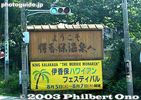
Ikaho is also a sister city of Hawaii island. During Aug. 5-7, 2003, Ikaho hosted the 7th King Kalakaua Merrie Monarch Hawaiian Festival featuring hula performances by numerous Japanese hula groups.
|
|
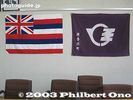
In the evenings, Hawaii's top hula halau (winner of the Merrie Monarch Festival in Hawaii) performed as the festival's main event. Photo: Flags of Hawaii and Ikaho town (merged with Shibukawa in 2006).
|
|
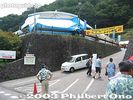
Town parking lot with a makeshift stage and main venue of the festival. The "Merrie Monarch" refers to King David Kalakaua who reigned over the Hawaiian Kingdom 1874-1891. He promoted hula in Hawaii as well as Japanese immigration to Hawaii.
|
|
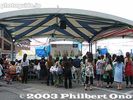
Canopy for the spectators fronting the main outdoor stage.
|
|
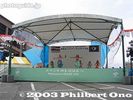
Main stage where many Japanese hula troupes performed during the day for three days. Free admission.
|
|
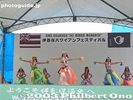
Tahitian dances were also performed.
|
|
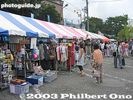
Hawaiian souvenirs for sale.
|
|
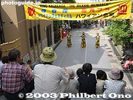
Ikaho is famous for the Stone Steps lined with shops. A section of it also served as a second hula stage during the day.
|
|

Hula on the Stone Steps 石段街
|
|
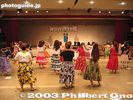
Hula workshops are also offered during the day at cost. A famous kumu hula teacher from Hawaii teaches the class.
|
|
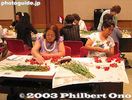
Other workshops are held such as ukulele lessons and a lei-making class.
|
|
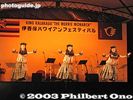
In the evenings, the overall winner of the annual Merrie Monarch Festival in Hawaii performed on stage. In 2003, it was Hula Halau 'O Kamuela from Oahu. They performed both the ancient hula kahiko dances (pictured here) and modern auana dances in Ikah
|
|
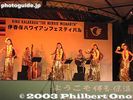
The Ikaho hula festival is officially sanctioned by The Merrie Monarch Festival, held in spring in Hilo, Hawaii. It is the most important and prestigious hula competition.
|
|
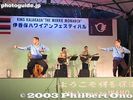
Hula is also performed by men. These photos were taken during the 7th Ikaho Hawaiian Festival (Aug. 5-7, 2003).
|
|
|
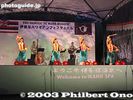
They wore a variety of colorful costumes and used various hula instruments such as these frayed bamboo sticks called Pūʻili.
|
|
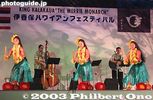
Modern hula dances such as this one is mainly for tourist entertainment.
|
|
|
|
|
|

After the bamboo sticks, the girls used a gourd drum called ipu.
|
|
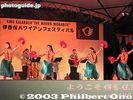
Finally, they use feathered gourd rattles called Ulīʻulī.
|
|
|
|
|

They are professional hula dancers, some of the best in the world.
|
|

The kumu hula is Kamana'o Anson Kauionalani or Kaui for short. He does a solo dance here. The music was performed by a wonderful Hawaiian trio called 'Ale'a.
|
|
|

Main venue of the Ikaho Merrie Monarch Hawaiian Festival held every summer in Ikaho Spa, Gunma Prefecture since 1997. It is on a city-operated parking lot. 伊香保ハワイアンフェスティバル会場
|
|

The main venue has two large adjoining tents. The tent on the left covers the stage, and the one on the right covers the audience seats. The place is ringed by outdoor shops selling Hawaiian goods (mainly clothing).
|
|

About 600 seats at the main venue. Ikaho's connection to Hawaii lies with the summer residence of Robert Walker Irwin, the Hawaiian Minister to Japan during the late 19th century.
|
|

The Hawaiian festival's opening ceremony was held on the festival's first day on Aug. 3, 2008. Among Japan's many hula festivals, this one is unique since it is organized by a city government based on sister-city ties.
|
|

The opening ceremony included a few speeches and a ukulele performance by Mr. San'uemon Chigira, the chairman of the festival committee.
|
|

Short greetings by Luana Saiki-Kawelu, Assistant Director of the Merrie Monarch Festival in Hilo, Hawaii. Ikaho's Hawaiian festival is Japan's only hula event officially endorsed by the Merrie Monarch Festival in Hilo.
|
|

A few words by Kau'i Kamana'o, kumu hula of Hula Halau 'O Kamuela who was the festival's guest performer and overall winner of the 2008 Merrie Monarch Festival in Hilo, Hawaii.
|
|

Kumu hula Kunewa Mook also speaks at the opening ceremony. In the background is the flag of the city of Shibukawa. In Japan, all cities, towns, and villages have their own official logo and flag.
|
|

Kumu hula Aloha Dalire, instructor of the Hawaiian seminars during the festival, also greets the audience. アロハ・ダリレ
|
|

Thomas Goya, from Hilo and president of the Japanese Community Association of Hawaii, speaks as a representative of the County of Hawai'i, Ikaho's sister city. ハワイ島日系人協会会長
|
|
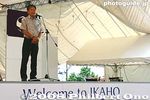
Tommy Hirano, Honorary Consul-General of Japan from Hilo, Hawaii also speaks. It was his first visit to Ikaho.
|
|

Signboard at the entrance to Ikaho Spa. ("Monach" is spelled wrong.) "Monach"はスペルミス。
|
|

Main venue of the Ikaho Hawaiian Festival. メイン会場
|
|

Shops around the main venue.
|
|

More shops on the lower level.
|
|
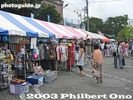
Shops on the lower level.
|
|

During Aug. 3-6, 2008, about 390 hula groups (totaling 4,700 people) performed on this stage. About 838 hula groups applied to perform, and only 390 could be selected to appear.
|
|
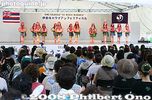
Every 4 minutes, a new group of hula dancers went on and performed on stage. This went on for four days 10 am to 6 pm (except on the first day when it started from 1 pm).
|
|

The first day featured Keiki Hula (hula by children).
|
|

Once upon a time, hula in Japan was mainly done by elderly women. Not anymore as hula's popularity has spread to all ages in Japan.
|
|

All the seats were filled during the all-day performances. So many hula groups applied to perform during the festival that Ikaho had to draw lots to decide who could appear.
|
|

For many women, hula is good exercise, recreational fun, or a chance to look and feel like a different person. The colorful costumes, flowers, attractive movements, and glamorous setting are all very appealing.
|
|

Kupuna 4分ごとに各フラチームがステージで出演。
|
|

The famous Stone Steps of Ikaho. Ikaho is on a mountain slope, and the Stone Steps goes through the center of the hot spring town. It is lined with shops and inns. ("Monach" is spelled wrong.) "Monach"はスペルミス
|
|

One section of the Stone Steps also served as another venue for Ikaho's Hawaiian Festival. 「街角フラ」石段にて
|
|

This venue is called "Machikado Hula." (Street corner hula). It went on from 11 am to 5 pm during the four-day festival (except on the first day when it started from 1 pm).
|
|

The audience sit on the Stone Steps to watch the "Street corner hula." So what did they do when it rained?
|
|

A few hula dancers take a break after performing their number on the Stone Steps.
|
|

A total of five 90-min. Hawaiian seminars were held during Ikaho's Hawaiian festival in Aug. 2008, and they were all taught by kumu hula Aloha Dalire who was very well received by the (thrilled) students.
|
|

Kumu hula Aloha Dalire explains that she is a 7th-generation kumu hula in her family, and produced five Miss Aloha Hulas at the Merrie Monarch Festival in Hilo, including all three of her daughters and Kuhi Suganuma, the 2008 Miss Aloha Hula.
|
|

Aloha Dalire taught seminars in hula history, Hawaiian expression, and lei-making (pictured here). She brought a boxful of a'ali'i flowers for lei-making. All the students had heard of the flower, but it was the first time for them to see it.
|
|

Aloha also taught two hula workshops. For the first workshop, she taught the song "Nani Lawa'i" (sung by Na Palapalai). First, she had the students close their eyes and listen to the song.
|
|

Aloha Dalire teaching hula in Ikaho. The Hawaiian workshops were held at the Ikaho Kaikan Hall in central Ikaho. アロハ・ダリレが教えるフラセミナー
|
|

For the second hula workshop, Aloha taught the song "Nani Manoa." The workshops were held at Ikaho Kaikan hall. 伊香保会館
|
|
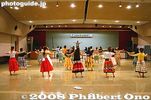
It cost 30,000 yen to take all five seminars or 10,000 yen for one seminar. The hula seminars were the most popular. Free ukulele lessons were also taught at a different venue by a Japanese teacher.
|
|

Students who attended all five Hawaiian seminars were given a Certificate of Completion signed by Aloha Dalire who enjoyed teaching the seminars. She then freely signed autographs and took pictures with the students.
|
|

From 7 pm to 8:30 pm, the Hawaiian Waiwai Party allowed anybody to go up front and dance the hula. Hawaiian music provided by a Japanese Hawaiian band (Dan Yamamoto & Ikaho Hawaiians).
|
|

Hawaiian Waiwai Party ("Waiwai" means boisterous.)
|
|

After the Waiwai Party was a nightly drawing for prizes. People staying at any Ikaho inn/hotel would receive a lottery ticket which they put in this large box. The grand prize was a trip for two to Hawaii. The prize drawing was held on all four nights.
|
|

Guests of Honor from Hawaii were introduced to the crowd.
|
|

The nightly main event was an hour-long Merrie Monarch hula show by Hula Halau 'O Kamuela, the overall winner of the 2008 Merrie Monarch Festival held in Hilo, Hawaii.
|
|

Every year, the overall winner of the Merrie Monarch Festival is invited to perform at Ikaho's Hawaiian festival. They started with a hula kahiko (ancient hula) dance.
|
|

This was a song about paddling a canoe, I think.
|
|

Dreamy stage lighting.
|
|

Colorful costumes and lots of eye candy.
|
|

Crowd-pleasing performance.
|
|

Kumu hula Kau'i Kamana'o does a solo number.
|
|
|

On the last day of the festival on Aug. 6, 2008, a closing ceremony was held at 8 pm before the prize drawing and Merrie Monarch Show. Luana Saiki-Kawelu gives a few words.
|
|

Aloha Dalire also speaks during the closing ceremony.
|
|

Thomas Goya during the closing ceremony.
|
|

Tommy Hirano during the closing ceremony.
|
|

The Honorable Jiichi Kogure, mayor of Shibukawa, lauds the festival during the closing ceremony. 渋川市長 木暮治一
|
|

Mayor Kogure speaks with Aloha Dalire and Luana Kawelu after the Merrie Monarch Show.
|
|

On the last night of the festival, a farewell party was held for the Hawaii delegation. Shibukawa city council chairman Katsuaki Oshima (left) and Mayor Kogure pose with members of Hula Halau 'O Kamuela.
|
|

Members of Hula Halau 'O Kamuela try Japanese-style dancing during the farewell party.
|
|

Group shot of the Hawaii gang and Ikaho Hawaiian Festival Committee.
|
|

Hawaiian celebrities Aloha Dalire and Luana Kawelu pose with yet another group of Japanese hula dancers in a hotel lobby in Ikaho.
|
|
|
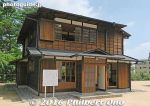
Robert Walker Irwin's summer residence in Ikaho, next to the Stone Steps. He was the Hawaiian Minister to Japan during the late 19th century. He coordinated the immigration of Japanese to Hawaii. ロバート W. アルウイン別邸
|
|

In 1985, the 100th anniversary of the Japanese immigration to Hawaii, Ikaho designated this residence as one of the town's Historic Places. ハワイ王国公使別邸
|
|

This modest building is only part of what was a larger complex of Irwin's summer residence. This is the front entrance. Open to the public, free admission.
|
|

Robert Walker Irwin's summer villa was moved to its present and original location in fall 2013. Map here.
|
|

If the house is boarded up like this, it's probably closed. The Irwin house is closed on Tuesdays.Getting here: From the Buster Shinjuku bus terminal at JR Shinjuku Station (near South Exit) in Tokyo, there are JR buses to Ikaho, taking 2.5 hours. Get off at the Ikaho Ishidangai stop (伊香保石段街) at the bottom of the Stone Steps. Day trippers can store luggage in the nearby lockers. Irwin's villa is a short distance up the Stone Steps on the right side.
|
|
|
|
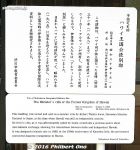
About the "Minister's Villa of the Former Kingdom of Hawaii" ハワイ王国公使別邸 (英語がちょっと変)地元の子供達の英語教育を担当している教育委員会の英文は特にしっかりしたものにして欲しいですね。こんな英語で手本にもならないし、英語の勉強にもならない。読む外国人さんも笑わせる。
|
|

The Irwin house and museum are open 9 am to 4:30 pm (enter by 4:15 pm). Closed Tuesdays and Dec. 28–Jan. 4.
|
|

First floor of Robert Walker Irwin's summer residence in Ikaho. When the house was moved, it was disassembled and repaired before reassembly.
|
|

This first floor originally had tatami mats. You still need to take off your shoes to enter.
|
|

Robert Irwin spent his summers in Ikaho from when he bought the villa in 1891 until 1925 when he died. It was an inn when he bought it.
|
|

Second floor has tatami mats. The second floor is open to the public only on weekends and during the hula festival in summer.
|
|

After Irwin bought the house, he fixed it up by reinforcing the walls against earthquakes with diagonal beams.
|
|

After Irwin died, the house was sold to Kodansha, a publishing company, and used for employee training. Eventually, the house was acquired by Gunma Prefecture and later by Ikaho/Shibukawa.
|
|
|
|
|

Second floor
|
|

View of garden from second floor.
|
|
|

The Irwin house is on the left, and a small museum called the Guidance Facility is on the right.
|
|

Map of the Irwin Park.
|
|
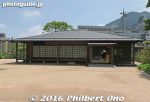
Irwin house Guidance Facility, a small museum showing Irwin artifacts.
|
|
|

Guidance Facility
|
|

The Irwin Guidance Facility has exhibits about Robert Walker Irwin, his Hawaii connection, and his life in Ikaho. A short video introduces him here.
|
|

A young Robert Walker Irwin.
|
|
|

Main exhibits on the left. No English as of July 2016.
|
|

They don't allow photography inside the museum.
|
|

Panel explaining Japan-Hawaii relations.
|
|

Items related to the Japanese immigration and Japanese-Americans in Hawaii.
|
|
|

Koa calabash bowl from Hilo, Hawaii to mark Ikaho's 100th anniversary in 1989.
|
|

Various printed matter related to the Japanese immigration and Japanese-Americans in Hawaii.
|
|

Booklet from Lorraine Inouye, then mayor of the Big Island.
|
|

Newspaper article about King Kalakaua's visit to Japan.
|
|

Panel about Robert and wife Takechi Iki.
|
|

Top panel about Robert Walker Irwin. Bottom panel about Irwin and wife Iki.
|
|

Iki and Robert Walker Irwin at the Imperial Palace for the promulgation of the Meiji Constitution in Feb. 1889. ロバート W. アルウインと妻のイキ
|
|

Certificate for the 2nd Class, Order of the Rising Sun, Gold and Silver Star (勲二等旭日重光章) Irwin received on Oct. 4, 1886. But the museum does not have the medal.
|
|

Irwin's decorative saber.
|
|

Wife Iki's belongings. Lower left is Iki's small dagger in a red case. Iki was from a samurai family.
|
|

Wife Iki's belongings. Iki wrote a poem on the upper left fan. Lower right are a few tourist souvenirs (Postcards and hand towel) Iki bought.
|
|

Left panel is about the Irwin family in Ikaho. Right panel is about Sophia "Bella" Arabella, Robert Irwin's eldest child.Bella Irwin established the Irwin Gakuen school and kindergarten アルウィン学園 in 1916 in Kojimachi. Today, the school is in Tokyo's Suginami Ward called Irwin Gakuen Gyokusei Hoiku Senmon Gakko.
|
|

Irwin family portrait and a travel permit that was required for foreigners to travel within Japan.
|
|
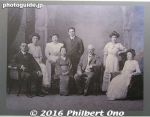
Left to right: Robert Jr., Bella, 4th daughter Agnes, Iki, 2nd son Richard, Robert, 3rd daughter Marion, and 2nd daughter Mary.
|
|

Robert Walker Irwin and oldest daughter Bella. Portrait taken when they visited the US.
|
|

Old 1902 map of Ikaho.
|
|

Old 1902 map of Ikaho with Irwin's summer home marked by the red circle. It was in front of the bottom of the Stone Steps which cuts through the center of the town.
|
|

The upper left is a woodblock print showing foreigners vacationing in Ikaho in 1882.
|
|

Dishes and cutlery used in Irwin's Ikaho residence. Most were imported from Europe and the US. Some are also from Japan.
|
|
|
|
|

Irwin carried these binoculars on walks and also always carried this cross and watch.
|
|

Sake cups with the Hawaiian flag. Gold color substituted for blue.
|
|
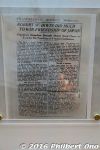
Obituary for Robert Walker Irwin in a Philadelphia Monday Morning newspaper in 1925.
|
|

Letter of condolence from Bella Irwin to the Chigira family written in romanized Japanese. The Chigira family operated an inn near the Irwin summer villa.
|
|

Letter from mother Iki to daughter Bella in 1909 about the Sunday School.
|
|

A few lamps, hibachi heater, and furniture used in the Irwin summer residence.
|
|

Cupboard was a gift from the Chigira family to the Irwins.
|
|

Irwin's furniture.
|
|

Wife Iki's winter coat.
|
|
|

Top panel shows the floor layout of Irwin's original Ikaho summer home. Bottom panel shows pictures of the present house being disassembled
|
|

Floor plan shows the original summer villa in Ikaho. The red portion is the part that remains today. The rest of the building was torn down due to age.
|
|

Ikaho Onsen is a well-known hot spring resort in Shibukawa, Gunma Prefecture. It is on hilly terrain, near mountains, making it cooler than Tokyo in summer.
|
|

Ikaho was a favored summer retreat for the Imperial family and political figures in the late 19th century. Ukiyoe print of Ikaho.
|
|

From Tokyo's Buster Shinjuku bus terminal at Shinjuku Station, it takes about 2 hr. 40 min. to Ikaho, costing about ¥2400.
|
|

From Tokyo, going by bus is more convenient than by train. By train from Tokyo, you need to take the shinkansen to Takasaki, transfer trains to Shibukawa, then take a bus to Ikaho.This is the Ikaho Stone Steps bus stop.
|
|

The Ikaho Stone Steps bus stop is at the bottom of the Stone Steps. The Ikaho Onsen bus stop is near other inns.
|
|

At the bottom of the Stone Steps is a waiting room and luggage lockers.
|
|

Ikaho is famous for these Stone Steps (Ishidan) which is the town's main drag. This is at the foot of the steps.
|
|

Ikaho's Stone Steps (Ishidan) go through the middle of the main part of Ikaho. Go up 365 steps to the top with a few breaks along the way. About 300 meters lined with shops and inns.
|
|

Hot spring cascade at the bottom of the Stone Steps.
|
|

Ikaho's spring water runs right below these Stone Steps and you can see it at a few places such as this cascade.
|
|

Hot spring cascade at the bottom of the Stone Steps. The flowing water is hot.
|
|
|
|
|

Ikaho Onsen Stone Steps
|
|
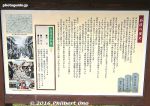
History of the Ikaho Stone Steps. The Stone Steps were first built in 1576 by daimyo Takeda Katsuyori after he lost to Nobunaga and Ieyasu at the Battle of Nagashino.He ordered the Sanada Clan to build the Stone Steps and have Ikaho's hot spring water flow down to feed 12 inns where Takeda's wounded soldiers could heal their wounds.
|
|

Looking at the bottom of the Ikaho Stone Steps.
|
|

Slightly up the Stone Steps is this outdoor stage where they hold hula performances in summer.
|
|
|
|

Irwin Garden
|
|

Lookout point at the garden.
|
|

View from Irwin Garden
|
|

Monument for Toyo Matsugane (1878–1964), a poet. 松根 東洋城
|
|
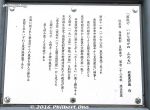
About Toyo Matsugane.
|
|
|

Ikaho Checkpoint (Ikaho Onsekisho) is right above the Irwin summer home.
|
|

Ikaho Checkpoint gate and Irwin summer home in the background.
|
|

Ikaho Checkpoint gate.
|
|

Ikaho Checkpoint. In the old days, travelers could not travel around freely, they had to show travel permits at these checkpoints along the road.
|
|

Ikaho Checkpoint was at the bottom of the Stone Steps. The bottom of the Stone Steps has since been extended more downward.
|
|

94th step of 300+ steps.
|
|
|
|

You can see the hot spring water gushing down under the Stone Steps. Not really a shrine.
|
|

Rubber duckies won at the shooting arcade game.
|
|

On the right is where you can see the hot spring water gushing down under the Stone Steps.
|
|

Along the way is this hot spring public bath called Ishidan-no-Yu. For people who are not staying in any of the inns, they can still dip into Ikaho's hot spring waters for cheap.
|
|

View from the Ishidan-no-Yu public bath.
|
|

Lounge inside Ishidan-no-Yu public bath.
|
|

Ishidan-no-Yu public bath sign. Open 9:00-21:00 (April to October), 9:00-20:30 (November to March), Closed on the second and fourth Tuesday of the month.
|
|

Tanabata
|
|

Tanabata wishes around July 7 along the Stone Steps.
|
|
|

Engraved on the steps here is a poem titled “Ikaho no Machi” (Town of Ikaho) by Akiko Yosano (1878-1942).
|
|

Free foot bath courtesy of a local inn.
|
|

Ikaho foot bath courtesy of a local inn.
|
|

Hot spring bath in a large hotel in Ikaho.
|
|

In Aug. 2004, along with other major onsen hot springs, Ikaho got caught in a major onsen scandal which started in Shirahone Onsen in Nagano. Onsen managers mixed in tap water and/or bath salts into the water and billed it as natural hot spring waters.Some of Ikaho's major hot spring inns were also found to be adding bath salts or tap water to the hot spring water. Today, all onsen inns must display a certificate indicating the content of their water.
|
|

Gunma-chan horse mascot
|
|

Ikaho souvenir shop
|
|

Kirie cut-out picture of Ikaho Stone Steps.
|
|

Map of Ikaho in the old days.
|
|

Behind the museum is a little plaza and the Stone Steps. The plaza has trees.
|
|

Behind the museum, this tree is dedicated to Dottie Thompson, founder of the Merrie Monarch Festival in Hilo, Hawaii (Ikaho's sister city).
|
|

Oriental zodiac creatures along the steps. Each of the 12 zodiac creatures indicate the location of the original 12 inns built in the 16th century to heal Takeda Katsuyori's soldiers.
|
|
|

Tree dedicated to Dottie Thompson.
|
|

Near the Irwin villa is a replica of a stone monument at Irwin's gravesite at Aoyama Cemetery in Tokyo. Inscribed with a short biography of Robert Walker Irwin.
|
|

Approaching Ikaho Shrine at the top of the Stone Steps.
|
|
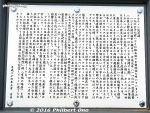
About Irwin
|
|
|
|

Ikaho Shrine
|
|

Steps to the garden below.
|
|

Ikaho Jinja Shrine's main building
|
|

Irwin's summer villa apparently included a garden like this.
|
|

Ikaho Shrine is dedicated to the god of the hot spring and medical treatment.
|
|
|

Seems to contain a mikoshi portable shrine.
|
|
|
|

Ikaho Shrine's ema tablets to write your wishes.
|
|

Ikaho Shrine
|
|

Ikaho Shrine
|
|

Lots of stone lanterns at Ikaho Shrine.
|
|
|
|

Poetry monuments
|
|
|
|
|
|

Secondary shrines
|
|
|
|
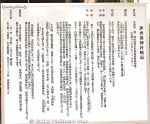
About Ikaho Shrine
|
|
|

Behind Ikaho Shrine, you can walk further to an outdoor bath near the spring water's origin.
|
|

Ikaho's sister-city exhibit in Machi-no-Eki building (ropeway terminal).
|
|

Sister-city exhibit for the County of Hawaii (Big Island).
|
|

Letter from Big Island Mayor Stephen Yamashiro proclaiming sister-city relations with Ikaho (before it merged with Shibukawa).
|
|

View of Ikaho from Machi-no-Eki, an exhibition room and ropeway station. Ikaho's first Hawaiian Festival was held here.
|
|
|
|

Inside Machi-no-Eki are displays of art work by local students.
|
|
|
|

Ropeway to Mt. Uenoyama, a mountain on whose slopes Ikaho sits.
|
|

Map of Mt. Uenoyama.
|
|

Lookout deck on Mt. Uenoyama.
|
|

View of Ikaho from Mt. Uenoyama.
|
|

View of Ikaho from Mt. Uenoyama.
|
|

Mt. Uenoyama also has recreational facilities.
|
|
|

Bus stop at Ikaho Stone Steps.
|
|
|
|